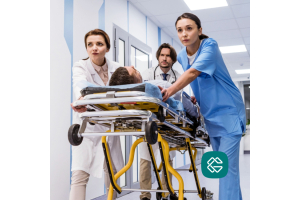Safe lifting is a critical part of workplace safety in healthcare settings — whether you’re moving a patient, lifting a sedated animal, or transferring medical supplies. Improper lifting can lead to musculoskeletal injuries, lost workdays, and even long-term disability.
This guide provides OSHA-informed best practices, tailored for human healthcare facilities and veterinary/animal care environments.
1. Why Safe Lifting Matters in Healthcare
Healthcare professionals face a higher-than-average risk of back injuries due to frequent lifting and repositioning of patients, animals, and equipment.
- Common causes of injury: Overexertion, awkward postures, sudden animal movement, lifting without help.
- Risks: Back strain, herniated discs, shoulder injuries, repetitive strain injuries.
- OSHA’s stance: Employers must provide a safe working environment, including proper training in safe lifting techniques.
2. OSHA Standards & Guidelines
While OSHA does not have a specific “safe lifting” standard, requirements fall under the General Duty Clause (Section 5(a)(1) of the OSH Act), which mandates that employers provide a workplace free from recognized hazards.
Relevant OSHA resources:
- OSHA 29 CFR 1910.176 – Handling materials, general.
- OSHA Ergonomics Guidelines for healthcare & veterinary workers.
- OSHA Safe Patient Handling Programs – applicable to human healthcare settings.
3. Assess Before You Lift
Before lifting a patient, animal, or object:
- Size up the load – Is it too heavy for one person?
- Check your route – Clear away trip hazards, water spills, or equipment.
- Plan your grip and stance – Know where your hands and feet will be.
- Ask for help or use assistive devices if the load is heavy, awkward, or unpredictable.
4. Safe Lifting Techniques
For human patients:
- Use mechanical lifts or transfer devices whenever possible.
- Communicate clearly with the patient and your team before moving.
- Keep the patient’s weight close to your body.
- Bend at the knees, not the waist, and lift with your legs.
For animals:
- Use restraint equipment (muzzles, harnesses, wraps) for safety.
- Have one handler control the head while others support the body.
- Lift animals with a team if over 25–30 lbs (especially large dogs or sedated animals).
- Avoid twisting your spine while lifting or holding an animal.
For equipment & supplies:
- Store heavier items at waist height to minimize bending or reaching.
- Keep your back straight, feet shoulder-width apart.
- Lift smoothly — no jerking motions.
5. Use the Right Equipment
- Gurneys & stretchers for patients and large animals.
- Hoists or lift tables in veterinary surgery and treatment areas.
- Slide boards, gait belts, or transfer sheets for human patient handling.
- Wheeled carts for moving supplies and medications.
6. Team Lifting Protocol
When more than one person is lifting:
- Designate a leader to count down and give movement cues.
- Lift in unison to avoid shifting weight unexpectedly.
- Keep communication clear and concise — especially when animals are involved.
7. Employer Responsibilities
While OSHA does not set a specific safe lifting standard, it’s considered best practice for employers to:
- Offer training in proper lifting techniques and safe patient/animal handling.
- Provide mechanical lifting devices and keep them in good working condition.
- Develop a safe lifting policy with clear weight guidelines and procedures to promote consistency.
- Foster a workplace culture where staff feel comfortable asking for assistance without hesitation.
8. Employee Responsibilities
- Follow safe lifting procedures every time.
- Use assistive devices and request help when needed.
- Report hazards, defective equipment, or unsafe conditions promptly.
- Participate in training and refreshers.
9. Special Considerations for Animal Care
- Animals can move unpredictably — safety for the handler comes first.
- Sedation may be necessary for large or aggressive animals during lifting.
- Always consider infection control and wear PPE when appropriate.
10. Key Takeaways
- Safe lifting is everyone’s responsibility.
- Injuries are preventable with planning, proper technique, and teamwork.
- Employers must provide resources, training, and equipment to reduce risk.
Disclaimer: The information contained in this blog is for general informational purposes only and is not intended as legal, regulatory, compliance or other professional advice. Federal and state laws, rules, and regulations can change, and state laws may vary. As such, we make no warranties or representations about this blog’s information as complete, reliable, or suitable for your specific situation. Your reliance on any information contained in this blog does not establish a professional relationship with us and any such reliance by you is at your own risk. Always consult a qualified compliance professional before making decisions that could affect your compliance obligations. If you need assistance with your compliance responsibilities, please contact us.









